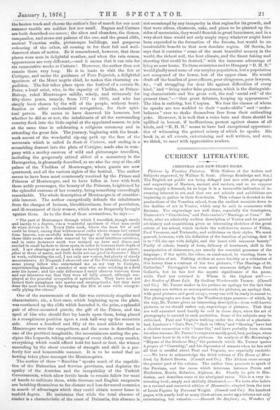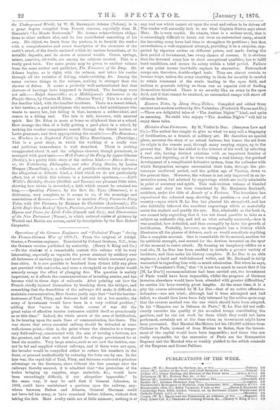CURRENT LITERATURE.
CHRISTMAS AND NEW-YEAR'S BOOKS.
Pictures by Venetian Painters. With Notices of the Artists and Subjects engraved, by William 13. Scott. (George Routledge and Son.) The English art public are being deluged just now with photographs and engravings of Masters, ancient and modern, and es we suppose these supply a demand, let us hope it is a favourable indication of in- creasing interest in art, and that our art schools and exhibitions are beginning to gather in their first-fruits. This volume is devoted to the productions of the Venetian school, from the earliest mosaists down to the decline of art in Venice, which may bo said to commence with Bassano. The engravings are well done, especially the frontispiece, Tintoretto's "Crucifixion," and Padovanino's" Marriage at Cana." Mr Scott, after an admirably written description of Venice and its general art-history and acquisitions, gives us interesting sketches of the great artists of her school, which include the well-known names of Titian, Paul Veronese, and Tintorotto, and criticisms on their styles. We must quarrel, however, with his definition of the function of painting, that it is to " fill the eye with delight, and the heart with sensuous beauty." Purity of colour, beauty of form, delicacy of treatment, skill in the manipulation of chiaroscuro, are merely the essential grammar of the language ; if the spirit, the ideas, so condemned, be wanting, there is degradation of art. Nothing strikes us more forcibly as a refutation of this heresy than a contrast of the two pictures, " The Marriage of St. Catharine." Correggio's has even more sensuous delight than Paul Crates, but he has lost the mystic significance of the poem, while Paul has retained it. Whose is the highest art?— Art Studies of Home Lift. By Godfrey Wordsworth Turner. (Cassell and Co.) Mr. Turner makes in his preface an apology for the fact that his essays are written as accompaniments for pictures, an apology that, with good pictures and good essays, every one will be ready to assent to. The photographs are done by the Woodbury-type process—of which, by the way, Mr. Turner gives an interesting description—from well-known pictures, or we should rather say, engravings of pictures. That they are well executed need hardly be said in these days, when the art of photography is carried to such perfection. Some of the subjects may be criticised. Paul and Virginia walking under the shade of a plantain- leaf, Landseer's "Cat's Paw," " Jack in Office," and " Shoeing," have but a slender connection with " home life," and have probably been chosen for other reasons. Mr. Turner's essays are mostly good, best, perhaps, when they have least to do with the pictures. An analysis of Mr. Browning's "Rhyme of the Duchess May," the pastorals which Mr. Turner quotes it propos of "Courtship," and his digression of sonnets when he has said all that is needful about Paul and Virginia, are especially readable. —We have to acknowledge the third volume of The Races of Man- kind, by Robert Brown. (Cassell and Co.) The African races occupy the greater part of the volume. The author then proceeds to speak of the Persians, and the races which intervene between Persia and Hindostan, Kurds, Beluchis, Afghans, &c. Finally he gets to Hin- dostan, and describes some of the aboriginal races. This is a very in- teresting book, amply and skilfully illustrated.— We have also before us a revised and corrected edition of Mommatia, adapted from the text of Louis Figuier by Perceval Wright. (Cassell and Co.) Six hundred pages, with nearly half as many illustrations, make rqta volume not only entertaining, but valuable.—Beneath the Surface I or, Wonders of the Underground World, by W. H. Davenport Adams (Nelson), is in a great degree compiled from French sources, especially from M. Simonin's "Le Monde Sonterrain." Mr. Adams acknowledges obliga- tions to other authors also, and be has contributed something of his own. His object, we learn from the preface, is to furnish the reader with a comprehensive and exact description of the structure of the earth's crust, of the fossils enclosed within its various formations, of its metallic deposits, and its stores of mineral wealth. Caves, springs, mines, quarries, oil-wells, are among the subjects treated. This is a really good book. The same praise may be given to another volume from the same author and publisher, The Treasures of the Deep. Mr. Adams begins, as is right, with the salmon, and takes his reader through all the varieties of fishing, whale-catching, &c. Among the many curious things in the volume, nothing is stranger than the shower of fishes. It seems a perfectly well-authenticated fact that showers of herrings have happened in Scotland. The herrings were not salt.—Ralph Somerville; or, a Midshipman's Adventures in the Pacific Ocean, by Charles H. Eden. (Marcus Ward.) This is a story of the familiar kind, with the familiar incidents. There is a desert island, a fair heroine, a good midshipman who marries, a bad midshipman who wants to marry her, but failing in that, becomes a robber-chief, and comes to a fitting end. The tale is told, however, with unusual spirit. But Mr. Eden is more at home on shipboard than at a school. How strange the idea of a bully getting a good place in a school, by making his weaker companions search through the Greek lexicon or Latin grammar, and then appropriating the results !—The Brandotas ; or, Workers in a Neglected Field, by Eliza Hutchinson. (Partridge.) This is a good story, in which the working of a really wise mad judicious benevolence is well described. There is nothing exaggerated about it, and the religious element, though prominent, is managed with good taste.-- Will Foster of the Ferry, by Agnes Giberne (Seeley), is a pretty little story of the serious kind.—Baron Bruno ; or, the Unbelieving Philosopher, and other Fairy Stories, by Louisa Morgan (Macmillan), is a collection of prettily-written fairy stories of the allegorical or didactic kind, a kind which we do not particularly affect, but of which this volume is a favourable specimen.—Little Willie's Birthday Stories (Griffith and Farran) are pleasant little tales, showing how virtue is rewarded, a faith which cannot be retained too long.—Speaking Flowers, by the Rev. Dr. Tyas (Bemrose), is a dictionary, very complete, as it seems to us, of the meanings and associations of flowers.—We have to mention Forty Favourite Fairy Tales, with 200 Pictures, by Madame de Chatelain (Lockwood); The Little Boys Own Book of Sports, Pastimes, and Amusements (Lockwood); Hymns and Poems for Little Folks (Cassell and Co.); and Illustrations of the New Testament (Warne), in which reduced copies of pictures by Westall and Martin are accomi anied by descriptions by the Rev. Hobart Carpenter.











































 Previous page
Previous page